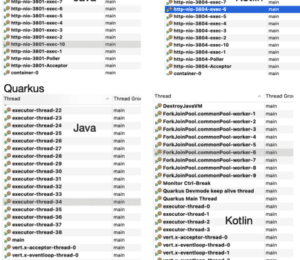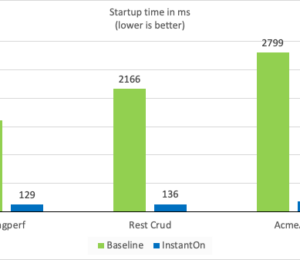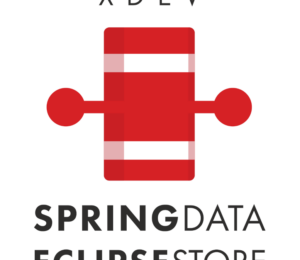Kicking Spring Native’s Tires
- March 22, 2021
- 2225 Unique Views
- 6 min read
I've been playing with GraalVM Ahead-Of-Time compilation capability since I became aware of it. As a long-time Spring aficionado, I carefully monitored the efforts that the engineers at Tanzu have put into making Spring AOT-compatible. Recently, they announced the beta version of the integration.
In this post, I want to check how easy it is to produce a (working!) Docker image from an existing Spring Boot application.
Introduction
GraalVM provides many different features. Among them, the component known as Substrate VM allows to AOT-compile regular bytecode to a native executable. The process "walks" the application starting from the main method at build time. Substrate VM leaves out the code that it doesn't follow out from the resulting binary.
For Spring applications, that's a big issue. The framework does a lot of work at runtime e.g., classpath scanning and reflection.
The usual way to cope with this limitation is to record all interactions with the application running on a JVM via a Java agent provided by Graal VM. At the end of the run, the agent dumps out all recorded interactions into dedicated configuration files:
- Reflective access
- Serialized classes
- Proxied interfaces
- Resources and resource bundles
- JNI
This option is compelling and allows one to create native images out of nearly every possible Java application. It comes with a couple of downsides, though, as you need:
- A complete GraalVM distribution that provides the agent
- A test suite that tests every nook and cranny of the application
- A process that executes the suite and creates the configuration files with every new release
None of these items are complicated, but the process is time-consuming and error-prone. It can be automated, but there's always a risk that a specific release forgets to test a particular use-case and crashes when deployed.
Experimenting with Spring Native
In the true Spring spirit, Spring Native aims to ease the configuration. The main idea is to provide "hints" directly in the code. A dedicated plugin will use these hints and generate the required configuration files. The Spring team has already provided those hints for the framework's code. You can also annotate your application's code if necessary.
To experiment with Spring Native, I used my imperative-to-reactive demo code. It offers a couple of challenges concerning AOT:
- It's a Spring application
- I use annotations and rely on runtime reflection and classpath scanning
- I use Kotlin
- I use H2, an in-memory database
- Finally, I cache serialized entities within an embedded Hazelcast instance. This is important as serialization is part of the improvements that GraalVM's latest version provides.
The first step is to make the application compatible with GraalVM. We need to remove Blockhound from the code. Blockhound allows verifying that no blocking code runs in unwanted places. It's a Java agent that requires a JDK, not a JRE. It's great for a demo, but it has nothing to do with a production application.
At the moment of this writing, GraalVM offers two versions of Java, 8 and 11. Since the demo initially uses Java 14, we need to downgrade Java's version from 14 to 11. Since the project is in Kotlin anyway, it has no other impact.
The second step is to add a dependency and a plugin to the POM. I put both into a dedicated profile so that the application can run "normally". These are hosted outside of Maven Central in dedicated Spring repositories.
<profiles>
<profile>
<id>native</id>
<build>
<plugins>
<plugin>
<groupId>org.springframework.experimental</groupId>
<artifactId>spring-aot-maven-plugin</artifactId>
<version>0.9.0</version>
<executions>
<execution>
<id>generate</id>
<goals>
<goal>generate</goal>
</goals>
</execution>
</executions>
</plugin>
</plugins>
</build>
<dependencies>
<dependency>
<groupId>org.springframework.experimental</groupId>
<artifactId>spring-native</artifactId>
<version>0.9.0</version>
</dependency>
</dependencies>
</profile>
</profiles>
<repositories>
<repository>
<id>spring-release</id>
<url>https://repo.spring.io/release</url>
</repository>
</repositories>
<pluginRepositories>
<pluginRepository>
<id>spring-release</id>
<url>https://repo.spring.io/release</url>
</pluginRepository>
</pluginRepositories>
With this configuration snippet, one can create a native image with the native profile:
mvn spring-boot:build-image -PnativeFirst Hurdles
The AOT compilation process takes a long time. It should succeed (though it displays some stack traces), and in the end, it produces a Docker image. You can run the image with:
docker run -it --rm -p8080:8080 docker.io/library/imperative-to-reactive:1.0-SNAPSHOT #1
- I use
--rmso it removes the container after it has run and doesn't waste disk space
Unfortunately, this fails with the following exception:
Caused by: java.lang.ClassNotFoundException: org.springframework.boot.autoconfigure.r2dbc.ConnectionFactoryConfigurations$PooledConnectionFactoryCondition
at com.oracle.svm.core.hub.ClassForNameSupport.forName(ClassForNameSupport.java:60) ~[na:na]
at java.lang.Class.forName(DynamicHub.java:1260) ~[na:na]
at org.springframework.util.ClassUtils.forName(ClassUtils.java:284) ~[na:na]
at org.springframework.util.ClassUtils.resolveClassName(ClassUtils.java:324) ~[na:na]
... 28 common frames omitted
It seems that Spring Native missed this one. We need to add it ourselves. There are two ways to do that:
- Either via annotations from the Spring Native dependency
- Or via standard GraalVM config files
In the above section, I chose to set Spring Native in a dedicated Maven profile. For that reason, let's use regular configuration files.
[
{
"name":"org.springframework.boot.autoconfigure.r2dbc.ConnectionFactoryConfigurations$PooledConnectionFactoryCondition",
"methods":[{"name":"<init>","parameterTypes":[] }]
}
]
Building and running again yields the following:
Caused by: java.lang.NoSuchFieldException: VERSION
at java.lang.Class.getField(DynamicHub.java:1078) ~[na:na]
at com.hazelcast.instance.BuildInfoProvider.readStaticStringField(BuildInfoProvider.java:139) ~[na:na]
... 79 common frames omitted
This time, a Hazelcast-related static field is missing. We need to configure the missing field, re-build and re-run again. It still fails. Rinse and repeat: I'll spare you the details; please check the repo if you're interested.
Because I configure Hazelcast with XML, the whole XML initialization process is needed. At some point, we also need to keep a resource bundle in the native image:
{
"bundles":[
{"name":"com.sun.org.apache.xml.internal.serializer.XMLEntities"}
]
}
Unfortunately, the build continues to fail. It's still an XML-related exception though we configured the class correctly!
Caused by: java.lang.RuntimeException: internal error
at com.sun.org.apache.xerces.internal.impl.dv.xs.XSSimpleTypeDecl.applyFacets1(XSSimpleTypeDecl.java:754) ~[na:na]
at com.sun.org.apache.xerces.internal.impl.dv.xs.BaseSchemaDVFactory.createBuiltInTypes(BaseSchemaDVFactory.java:207) ~[na:na]
at com.sun.org.apache.xerces.internal.impl.dv.xs.SchemaDVFactoryImpl.createBuiltInTypes(SchemaDVFactoryImpl.java:47) ~[org.hazelcast.cache.ImperativeToReactiveApplicationKt:na]
at com.sun.org.apache.xerces.internal.impl.dv.xs.SchemaDVFactoryImpl.<clinit>(SchemaDVFactoryImpl.java:42) ~[org.hazelcast.cache.ImperativeToReactiveApplicationKt:na]
at com.oracle.svm.core.classinitialization.ClassInitializationInfo.invokeClassInitializer(ClassInitializationInfo.java:375) ~[na:na]
at com.oracle.svm.core.classinitialization.ClassInitializationInfo.initialize(ClassInitializationInfo.java:295) ~[na:na]
... 82 common frames omitted
Switching to YAML
XML is a huge beast, and I'm not expert enough to understand the exact reason behind the above exception. Engineering is also about finding the right workaround. In this case, I decided to switch from XML configuration to YAML configuration. It's simple anyway:
hazelcast:
instance-name: hazelcastInstanceWe shouldn't forget to add the above resource into the resource configuration file:
{
"resources":{
"includes":[
{"pattern":"hazelcast.yaml"}
]}
}
Because of missing charsets at runtime, we also need to initialize the YAML reader at build time:
Args = --initialize-at-build-time=com.hazelcast.org.snakeyaml.engine.v2.api.YamlUnicodeReaderWe need to continue adding a couple of reflectively-accesses classes, all related to Hazelcast.
Missing Proxies
At this point, we hit a brand new exception at runtime!
Caused by: com.oracle.svm.core.jdk.UnsupportedFeatureError: Proxy class defined by interfaces [interface org.hazelcast.cache.PersonRepository, interface org.springframework.data.repository.Repository, interface org.springframework.transaction.interceptor.TransactionalProxy, interface org.springframework.aop.framework.Advised, interface org.springframework.core.DecoratingProxy] not found. Generating proxy classes at runtime is not supported. Proxy classes need to be defined at image build time by specifying the list of interfaces that they implement. To define proxy classes use -H:DynamicProxyConfigurationFiles=<comma-separated-config-files> and -H:DynamicProxyConfigurationResources=<comma-separated-config-resources> options.
at com.oracle.svm.core.util.VMError.unsupportedFeature(VMError.java:87) ~[na:na]
at com.oracle.svm.reflect.proxy.DynamicProxySupport.getProxyClass(DynamicProxySupport.java:113) ~[na:na]
at java.lang.reflect.Proxy.getProxyConstructor(Proxy.java:66) ~[na:na]
at java.lang.reflect.Proxy.newProxyInstance(Proxy.java:1006) ~[na:na]
at org.springframework.aop.framework.JdkDynamicAopProxy.getProxy(JdkDynamicAopProxy.java:126) ~[na:na]
at org.springframework.aop.framework.ProxyFactory.getProxy(ProxyFactory.java:110) ~[na:na]
at org.springframework.data.repository.core.support.RepositoryFactorySupport.getRepository(RepositoryFactorySupport.java:309) ~[na:na]
at org.springframework.data.repository.core.support.RepositoryFactoryBeanSupport.lambda$afterPropertiesSet$5(RepositoryFactoryBeanSupport.java:323) ~[org.hazelcast.cache.ImperativeToReactiveApplicationKt:2.4.5]
at org.springframework.data.util.Lazy.getNullable(Lazy.java:230) ~[na:na]
at org.springframework.data.util.Lazy.get(Lazy.java:114) ~[na:na]
at org.springframework.data.repository.core.support.RepositoryFactoryBeanSupport.afterPropertiesSet(RepositoryFactoryBeanSupport.java:329) ~[org.hazelcast.cache.ImperativeToReactiveApplicationKt:2.4.5]
at org.springframework.data.r2dbc.repository.support.R2dbcRepositoryFactoryBean.afterPropertiesSet(R2dbcRepositoryFactoryBean.java:167) ~[org.hazelcast.cache.ImperativeToReactiveApplicationKt:1.2.5]
at org.springframework.beans.factory.support.AbstractAutowireCapableBeanFactory.invokeInitMethods(AbstractAutowireCapableBeanFactory.java:1845) ~[na:na]
at org.springframework.beans.factory.support.AbstractAutowireCapableBeanFactory.initializeBean(AbstractAutowireCapableBeanFactory.java:1782) ~[na:na]
... 46 common frames omitted
This one is about proxies and is pretty straightforward. In this context, Spring Data proxies the PersonRepository interface through a couple of other components. Those are all listed in the stack trace. GraalVM can handle proxies but requires you to configure them.
[ ["org.hazelcast.cache.PersonRepository", "org.springframework.data.repository.Repository", "org.springframework.transaction.interceptor.TransactionalProxy", "org.springframework.aop.framework.Advised", "org.springframework.core.DecoratingProxy"] ]
And Now For Serialization
With the above configuration, the image should start successfully, which makes me feel all warm inside:
2021-03-18 20:22:28.305 INFO 1 --- [ main] o.s.nativex.NativeListener : This application is bootstrapped with code generated with Spring AOT . ____ _ __ _ _ /\\ / ___'_ __ _ _(_)_ __ __ _ \ \ \ \ ( ( )\___ | '_ | '_| | '_ \/ _` | \ \ \ \ \\/ ___)| |_)| | | | | || (_| | ) ) ) ) ' |____| .__|_| |_|_| |_\__, | / / / / =========|_|==============|___/=/_/_/_/ :: Spring Boot :: (v2.4.3) ...blah blah blah... 2021-03-18 20:22:30.654 INFO 1 --- [ main] o.s.b.web.embedded.netty.NettyWebServer : Netty started on port 8080 2021-03-18 20:22:30.655 INFO 1 --- [ main] o.s.boot.SpringApplication : Started application in 2.355 seconds (JVM running for 2.358)
If we access the endpoint at this point, the app throws a runtime exception:
java.lang.IllegalStateException: Required identifier property not found for class org.hazelcast.cache.Person!
at org.springframework.data.mapping.PersistentEntity.getRequiredIdProperty(PersistentEntity.java:105) ~[na:na]
AOT left out serialized classes, and we need to manage them. As for proxies, GraalVM knows what to do, but it requires an explicit configuration. Let's configure the Person class as well as the classes of its properties:
[
{"name":"org.hazelcast.cache.Person"},
{"name":"java.time.LocalDate"},
{"name":"java.lang.String"},
{"name":"java.time.Ser"}
]
Success!
Now, we can (finally!) curl the running image:
curl http://localhost:8080/person/1 curl http://localhost:8080/person/1
The output returns the expected result:
2021-03-15 09:54:18.994 INFO 1 --- [onPool-worker-3] o.h.c.CachingService : Person with id 1 not found in cache 2021-03-15 09:54:19.108 INFO 1 --- [onPool-worker-3] o.h.c.CachingService : Person with id 1 put in cache 2021-03-15 09:54:46.694 INFO 1 --- [onPool-worker-3] o.h.c.CachingService : Person with id 1 found in cache
We need to configure the Sort class to work with the root '/' endpoint, which retrieves all entities at once.
Conclusion
Despite all the "magic" of Spring Boot, Spring Native handles most of GraalVM's required configuration out-of-the-box. The steps described above are mainly specific to the application's code.
While the application is just a demo application, it's not trivial either. It's promising to see the native image working despite serialization, in-memory cache, and in-memory database.
Of course, not everything is perfect: the build displays some exceptions, some logs are duplicated at runtime, and it seems the Hazelcast node cannot join a cluster.
Yet, it's good enough, especially regarding the amount of time I spent. I'm eager to try the 1.0 version. In the meanwhile, I'll probably investigate a bit more closely the remaining warnings.
The complete source code for this post can be found on GitHub.
To go further:
Originally published at A Java Geek on March 22nd 2021
Don’t Forget to Share This Post!









Comments (0)
No comments yet. Be the first.